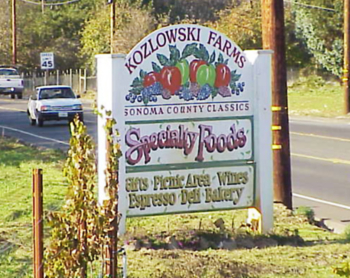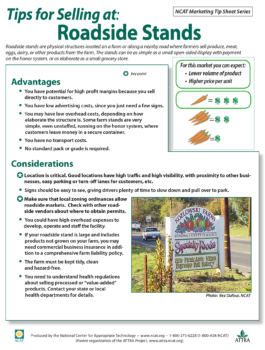Tips for Selling at Roadside Stands
NCAT Marketing Tipsheet Series
By Marisa Alcorta, Rex Dufour, and Tammy Hinman, NCAT Agriculture Specialists

Photo: Rex Dufour, NCAT
Roadside stands are physical structures located on a farm or along a nearby road where farmers sell produce, meat, eggs, dairy, or other products from the farm. The stands can be as simple as a small open-sided display with payment on the honor system, or as elaborate as a small grocery store.
For this market you can expect:
- Lower volume of product
- Higher price per unit
Advantages
- You have potential for high profit margins because you sell directly to customers.
- You have low advertising costs, since you just need a few signs.
- You may have low overhead costs, depending on how elaborate the structure is. Some farm stands are very simple, even unstaffed, running on the honor system, where customers leave money in a secure container.
- You have no transport costs.
- No standard pack or grade is required.
Considerations
Location is critical. Good locations have high traffic and high visibility, with proximity to other businesses, easy parking or turn-off lanes for customers, etc.
- Signs should be easy to see, giving drivers plenty of time to slow down and pull over to park.
- Make sure that local zoning ordinances allow roadside markets. Check with other roadside vendors about where to obtain permits.
- You could have high overhead expenses to develop, operate and staff the facility.
- If your roadside stand is large and includes products not grown on your farm, you may need commercial business insurance in addition to a comprehensive farm liability policy.
- The farm must be kept tidy, clean and hazard-free.
- You need to understand health regulations about selling processed or “value-added” products. Contact your state or local health departments for details.
Key Questions to Ask Yourself
Does my location get enough traffic to generate customers? Do I have space for parking? Can I put up sufficient signs to alert drivers and give them time and room to pull off the road?
- What hours and staffing would I need in order to run the stand effectively?
- What licenses, permits or zoning ordinances do I need to be aware of? Contact the state department of agriculture to find out.
Resources

Photo: Rex Dufour, NCAT
- ATTRA. Many relevant publications and resources are offered here, such as “Entertainment Farming and Agri-Tourism.”
- Developing a Roadside Farm Market (2006). Agricultural Alternatives, Pennsylvania State University. 6 pp. This is a good overview of what farmers should consider when setting up a roadside stand.
- New farm stand regulations expand options. University of California Small Farms program. This website provides updated, California-specific information about farmstand regulations.
- Roadside Stand Marketing of Fruits and Vegetables. This 40-page publication offers a wealth of information about marketing considerations, the shopping habits of roadside-stand customers, pricing, store layout, marketing tactics, impulse buying, popular fresh products, etc.
- The Structure of a Roadside Stand. Penn State Exstension.
- The Legal Guide for Direct Farm Marketing by Neil Hamilton. 1999. 235 pp spiralbound. Before selling their products directly to consumers, all farmers should consider these important issues. Learn about legal considerations behind farmers’ markets, business organization, contracts, food stamps, advertising and marketing, land use and property law, labor and employment, insurance and liability, food processing, and marketing meat, poultry, eggs, and dairy products.
- Facilities for Roadside Markets. Natural Resource, Agriculture and Education Service. 1992. 32 pp. Valuable for persons considering a roadside market or looking to improve or expand a current one. Chapters cover site considerations (visibility and accessibility, utilities, drainage, zoning, and building ordinances); market layout (areas for sales, preparation, shipping and receiving); market structure and facilities (parking, lighting, fire protection, security). Includes illustrations and plans.
Tips for Selling at Roadside Stands
By Marisa Alcorta, Rex Dufour, and Tammy Hinman, NCAT Agriculture Specialists
Published December 2012
© 2012
IP426
This publication is produced by the National Center for Appropriate Technology through the ATTRA Sustainable Agriculture program, under a cooperative agreement with USDA Rural Development. This publication was also made possible in part by funding from USDA/NIFA/OASDFR. ATTRA.NCAT.ORG.
Related Publications
- Tips for Selling at Farmers Markets
- Tips for Selling to Aggregators/Grower Marketing Coops
- Tips for Selling to Institutional Markets
- Tips for Selling to Wholesale Buyers at Terminal Markets
- Tips for Selling to Produce Distributors
- Tips for Selling to Produce Packing Houses
- Tips for Selling with Agritourism and “Pick-Your-Own”


